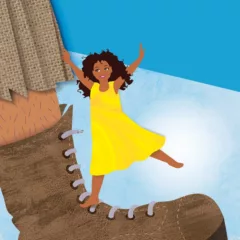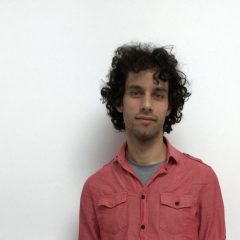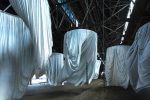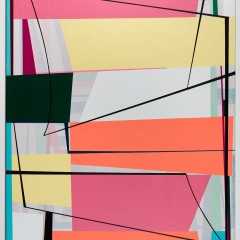by Diedra Krieger
I recently visited Costa Rica for some vacation time and a two-week artist residency. After a failed attempt one morning to make my way to the butterfly farm via public transport, I revised my adventure to search out the Museo de Arte Diseñeo y Contemporañeo in San José which was also confusing to find with my elementary Spanish on this humid day. The reward was viewing the exhibition, Diseño Responsible (Responsible Design).
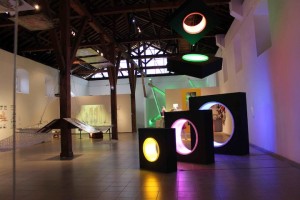
Ingrid Cordero & Oscar Ruiz Schmidt’s stop animation projection “La Niña Popof” looped in the gallery. The stop animation features cut-out photographs of two women modeling the duo’s second collection from their fashion label Pepegrillochachachá, which uses vintage textiles and vintage inspired designs from the 1950s to 1980s. In the video, the still photos of the women “dance” to a traditional mambo song while moving through a white-painted forest framed by a main stage. The white trees from the video were also used inside the gallery to frame the stop animation projection. The dance steps and expressive gestures dramatically change throughout the video, and with a swivel in the dancing, the wooden stands on which the cut out photos of the two models are mounted are revealed.
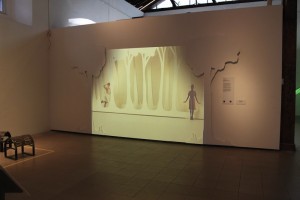
“La Niña Popof” was an extremely well executed stop animation. It was really short and focused, clocking in at one minute and fifteen seconds. I even watched it three times, part out of how great it was and part out of curiosity of figuring out where it began and ended. It was performance with dancing and who doesn’t love a good dance video. However despite all these reasons, I couldn’t quite work out why it was so provocative.
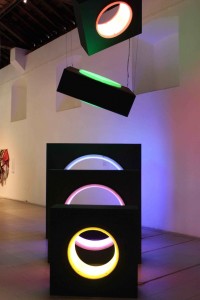
Still thinking about how awesome the video was, the music trailed in the background as I viewed other pieces in the show. Paco Cervilla’s over sized toy blocks made of postindustrial plastic and wood, hollow in the center and illuminated in bright colors still resonates. I was glad I had persevered to find this hidden gem, and it was free unlike the main museum.
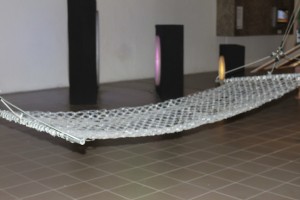
Francesco Bracci’s “Hamacas plásticas”, two hammocks made out of the tops of six packs of beer held together by zip ties, were especially inviting after walking around lost in the city. They were actually functional and one could lay down in them, which made me so happy. The hammocks reminded me of Joanie Turbek’s Prosthetic Lawn at the Clay Studio, where you could lay on the “lawn” grown in water bottles planters.
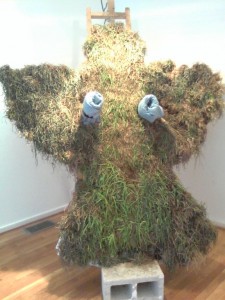
Now back at home in Philadelphia, I returned to slogging away at Susan Stewart’s book On Longing. Stewart, Susan. On Longing: Narratives of the Miniature, the Gigantic, the Souvenir, the Collection. Durham: Duke University Press, 1993. I had been reading a section about play. It hadn’t occurred to me that the stop animation and many pieces in the show were using play as a strategy for a very serious issue, the environment and the impact of consumption. Play and a deep concern for water issues are both close to my heart. Play has been a critical part of building and events for my ongoing art project Plastic Fantastic, a 16-foot geodesic dome made of over 6,000 post-consumer water bottles. Play is also the underlying motivation of my video performance practice. Play is serious business and it sneaked right by me. How could I not recognize play when I was viewing this exhibition and in particular the stop animation by Cordero & Ruiz Schmidt!
“The toy is the physical embodiment of the fiction: it is a device for fantasy, a point of beginning for narrative.” (56 Stewart) The stop animation motion is unlike everyday motion of video offering a playful device of movement and the cut out form of the women into a literal object or as it could be a toy, the video is indeed using play and invokes the imagination of the viewer. The upbeat sound of the mambo elevates the mood. With the music, dancing, and set our imaginations are set free to imagine a world of possibility. The aesthetic sensibility and content in Responsible Design were closely aligned with the strategies of the “Global Warming” exhibition at the Ice Box last year. Rather than being didactic, the artists lead by example, imagining, and proving how we can mindfully use natural resources and existing materials to drastically reduce our environmental impact, while valuing aesthetics and above all, play.
–Since 2007, Diedra Krieger has been working on the ongoing project Plastic Fantastic and most recently curated Filthy at Studio 34 Yoga | Healing | Arts . The pursuit of art has inspired self-referential video performance pieces. Follow her tweets at @diedrak.


